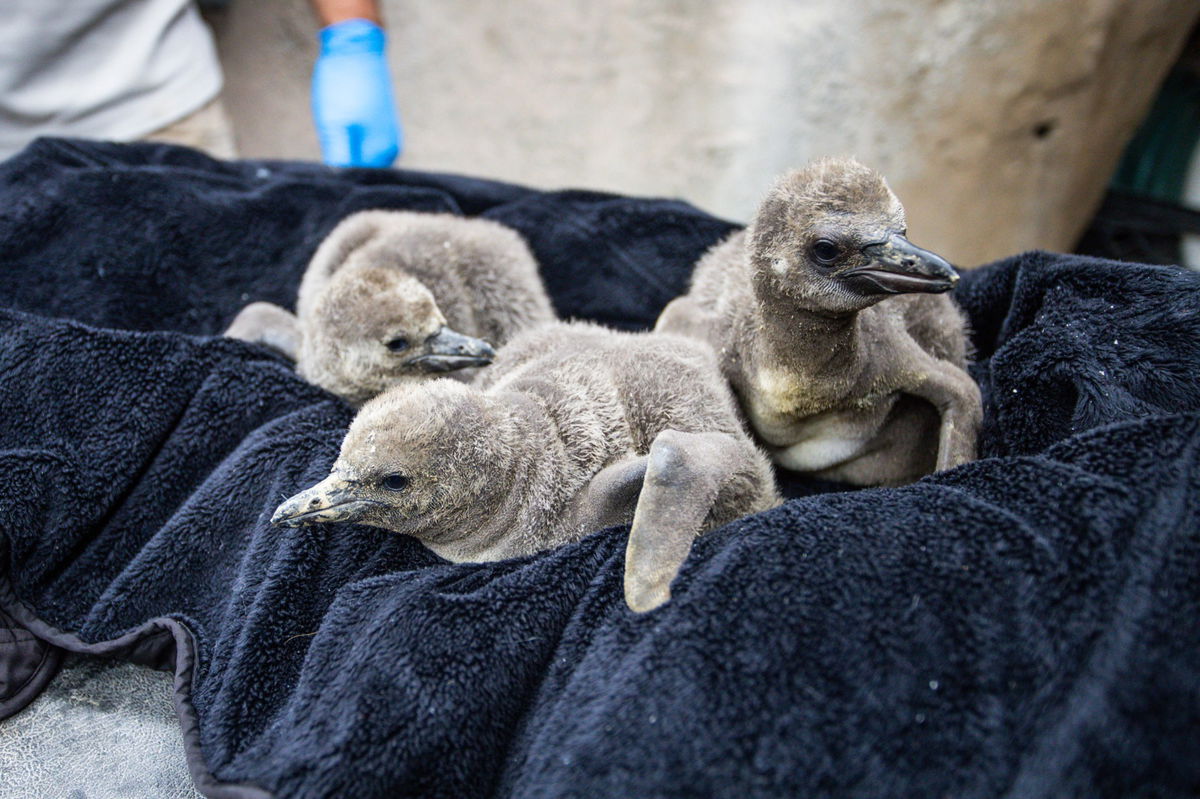Santa Barbara Zoo welcomes three new Humboldt baby penguins

SANTA BARBARA, Calif. – The Santa Barbara Zoo welcomed three new Humboldt penguin chicks to its animal family on Friday.
Below is a press release on the newest creatures at the Santa Barbara:
Santa Barbara, CA. (May 10, 2024) Santa Barbara, CA – The Santa Barbara Zoo is thrilled to announce the hatching of three Humboldt penguin chicks, marking the first penguin births at the Zoo since 2018. This exciting development brings a burst of joy and cuteness as they acclimate to their temporary home behind the scenes at the Zoo.
Chick #1 hatched on March 23, 2024, to proud parents Pepper and Pinga. Pepper, (age 7) born at the Zoo, is a fourth-generation penguin in the colony, continuing the legacy of his beloved father, Lucky, the famous penguin with a Teva shoe. Pinga, (age 8), came from the Columbus Zoo. This is their first chick and was co-reared initially, requiring special care from the zoo keepers before the parents began feeding it.
Chick #2 and #3 hatched on March 31 and April 2 respectively, and are siblings from parents Plum, (age 27) from SeaWorld San Diego (and an original Santa Barbara Zoo colony resident since 2006), and Jane, (age 11) from the Oregon Zoo; both are first-time parents. Chick #2 was raised by its biological parents Plum and Jane, while Chick #3 is being “foster-reared” by El Rey and Puff, both first-time parents from Woodland Park Zoo and Brookfield Zoo, respectively.
Humboldt penguins normally lay two eggs, but in the wild, the second chick often does not survive. Fortunately, the Zoo has the ability to foster the second egg to another pair so the birds have a chance to have parenting experience. All parents feeding chicks are offered additional opportunities to eat throughout the day.
All three chicks, now over 30 days old, have begun “fish school.” During this time, their waterproof feathers will grow in and they will learn essential skills including swimming in a small pool. They will also be weaned from regurgitated fish to freshly thawed fish provided by the keepers.
In a few weeks, these young penguins will be ready to make their debut in the habitat, but first, adult penguins from the colony will meet the chicks behind the scenes, and the chicks will also make visits to the penguin habitat. After those experiences, the young penguins will be brought back to live with the colony. Guests will be able to tell them apart from the rest of the colony by their silver and white appearance – they won't have the black "stripe" the adults have yet.
These penguin chicks play an important role in the sustainability of their species in human care, and are part of the AZA Humboldt Penguin Species Survival Plan. Humboldt penguins are listed as vulnerable on the IUCN Red List of Threatened Species. Primary threats in their native range include entanglement in fishing nets; illegal capture for food, bait, and the pet trade; and historic over-harvesting of guano (needed by the birds for nesting) for fertilizer.
Support the Flock!
The public can also help support the new penguin chicks by becoming a Foster Feeder sponsor of the penguin flock. Foster Feeders at all levels will receive a personalized Foster Feeder certificate (includes honoree’s name and animal photo) and recognition on the Foster Feeder board at the Zoo. Various donation levels are available with different, wild benefits! For more information click here: https://sbzoo.pivvit.com/humboldt-penguin
About Santa Barbara Zoo
The Santa Barbara Zoo is open daily from 9 a.m. for members and 9:30 a.m. for general admission until 5 p.m.; general admission is $25 for adults, $15 for children 2-12, and free for children under 2. Parking is $11. The Santa Barbara Zoo is accredited by the Association of Zoos and Aquariums (AZA). AZA zoos are dedicated to providing excellent care for animals, a great visitor experience, and a better future for all living things. With more than 200 accredited members, AZA is a leader in global wildlife conservation and is the public’s link to helping animals in their native habitats. Visit www.sbzoo.org.
Santa Barbara Zoo
